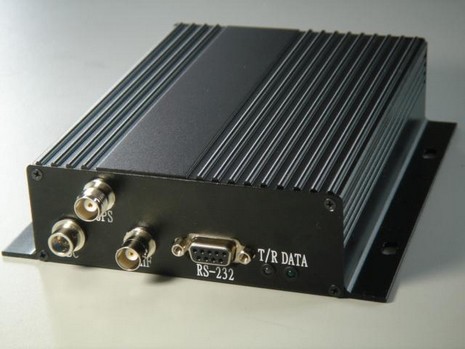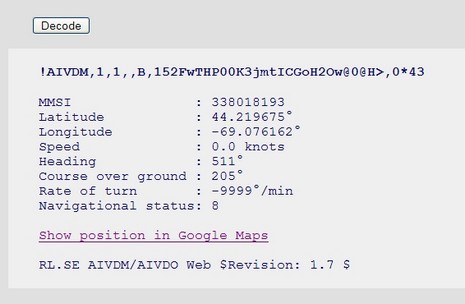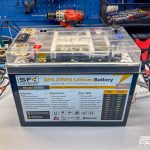Smart Radio SR261, pirate Class A AIS?

Above is the odd little Smart Radio SR261 “AIS Modem”, which claims “most of the functions of a class A ais transponder with a fraction of costs.” Let me say right up front that I absolutely do not recommend using this device, and think it may even endanger the AI system. Let me also note that the Chinese manufacturer, Smart Radio (SR), has nothing to do with similar-sounding Software Radio Technology (SRT), the British firm that builds all the circuit boards in the legitimate Class B transponders currently waiting an FCC waiver (take action!). And while Smart Radio is the manufacturer of the SR161 and 162 AIS receivers, I have heard nothing but praise for those units and particularly for the main U.S. distributor Milltech Marine.
In fact, Smart Radio is smart enough that it will not ship a SR261 transponder to the U.S. So how did I test one, however furtively in the confines of a concrete basement (with GPS antennas running out through a pipe)? Well, friends, it’s a tiny marble we live on. I recently met a sailor who happened to be passing through my neighborhood on break from an almost-around-the-marble cruise on his 30’ sloop. We got talking and—zounds!—he was lugging a SR261 in his suitcase so he could fool with programming it (not easy). He’d had a frightening near miss with a ship out in the Indian Ocean, and had met other blue water cruisers who’d bought these units online from China for about $700.
Well, I can tell you that it does work, sort of. Using an AIS receiver and Coastal Explorer, we could see the SR261 target across the basement, though we never got the vessel name or call sign we programmed into it. And another AIS program I have identified its signal as Class A. Plus a neat, but limited, online AIS message decoder further confirmed that at least its (CE-logged) AIVDM message translates into something vaguely sensible, as seen below. But, mind you, the SR261, and its SR260 sibling, aren’t like any other Class A, or B, transponders, not even close. They can supposedly act like either, at 5 watts, not 2 or 12; the user sets the time interval between dynamic message transmissions, instead of it being set according to speed and rules (!); and I think they only transmit on one channel. Plus I very much doubt that they can be controlled by shore authorities, a capability expensively built in to all approved As and Bs. What I really wonder, though, is if these SR transponders share the AIS frequencies properly with Class A and B devices that actually follow the standards? Maybe someone with more technical knowledge and/or better testing facilities can tell us.
One thing I do know is that the NMEA output of at least this particular unit seemed dicey. CE, normally excellent at NMEA 0183 parsing, wouldn’t recognize the data at all, though SeaClear II did, at least the GPS messages. Plus, the way you program the SR261 is by sending arcane codes into it using Hyperterminal, which also revealed the NMEA strings coming out of the unit. Some looked pretty funky to me. My new cruising friend says he’s seen AIS targets with this unit hooked up to MaxSea, but also that other cruisers are having a hard time getting data out of their SR261s. He’s now en route to another continent and hemisphere, with thousands of sea miles ahead of him, and I truly hope the transponder gives him great “see and be seen” service. And that he doesn’t pull into some port and have the authorities come out and confiscate it! “Pirate” may be too strong a word, but I really wonder if these Smart Radio transponders should be in use anywhere. And, sort of related, I wish that the Class B manufacturers could be making lots of U.S. sales right now and hence developing better and less expensive transponders (take action!).














Did you happen to open up the box to see which chipset it uses? (They have a photo on the website but it is not clear enough to tell.) I would doubt very much that a company like SR would have the resources to build their own, they are probably just packaging something like this: http://www.cmlmicro.com/Products/innovate/docs/Inv910.pdf
The SR website claims that the unit can be controlled from the shore. I don’t think that an AIS unit would even work if it couldn’t be, it has to negotiate for a slot assignment with other units.
Your concerns about overall quality may be well founded (how good is the radio circuit?) but I suspect that the basic AIS functionality probably works as well as any other product that uses that chipset. It is kind of equivalent to a cheap Chinese computer with an Intel chip inside; the power supply may be crud but it will run your windows programs.
I have looked at the specs for this device a few years back. This biggest problem with it is that I do not think that it will transmit in the standard AIS slots! This means that its transmissions will stomp all over the top of valid AIS transmissions.
I wouldn’t recommend its use with anything other than a dummy load and a screen room surrounding it.
Ben, Very interesting post regarding “bootleg” AIS transmitters. I share yours and Brian’s concerns about boaters misguidedly deploying these types of questionable devices. Curiously, I may have seen a couple just last week up in the San Juans. I was cruising with my Nobeltec AIS display active when lo and behold a strong AIS target flashed on about 2 nm in front of me, decoded as a “55 foot Nordhavn” (boat name withheld to protect innocent). A week later, another 55 foot Nordhavn blips on the screen down around Victoria with an equally strong target. Both boats had US hailing ports and were obviously well under the typical size and usage for Class A (or were they…out of frustration, are recreational boaters putting in Class A systems?) Is there something up with Nordhavn here, or just owners eager to get on board with the great AIS capabilities we all want?
Recreational boaters are definitely installing Class A AIS units, no worries about disclosing the name of the craft. Some out of frustration, others who like the higher power output and more frequent updates.
The regulations are about who is required to install Class A, there are no limitations on who may install Class A.
That’s why it’s so absurd for the FCC to be stalling, they’re just driving the market towards either the high end, Class A, or the illegal end (as described in Ben’s post).
There is a Yahoo group for discussion of the SR261
http://groups.yahoo.com/group/SR261/
The manual and some tips on programming it are available there.
From that group:
“Without external software, it only transmits on one frequency instead of alternating and it only listens on one frequency.”
I had a look at the specs for this unit a few years back and it worries s^%4 out of me! I think it uses an old GMSK modem chip inside, not the nice new wizzey AIS one in Georges’ post, so its performance must be suspect.
Its use in EU waters is definitely illegal as it doesn’t meet the requirements of the either the MED or the R&TTE directives and a contact at the UK’s MCGA has asked me to report any sightings within the UK so they can confiscate them.
As a mariner, please, please, please only use type approved equipment to transmit on AIS frequencies – lives may depend on it!
….possibly mine!
Hello,
We have contacted Smart Radio at Shenzhen trying to include their product to our list of Class B AIS Transponder that is on SiiTech website. They answered: “It is not good to post the SR261 in your website, the SR261 does not comply with the 62287-1, but may comply with the coming 62287-2. also the SR261 is not a common product at present stage, it is specially
ordered”.
SiiTech
http://www.siitech.com
Please be clear; this thing is not a Class B Transponder. It’s more of an AIS ‘modem’ and can send whatever AIS messages you tell it to.
It doesn’t behave like a Class A or B transponder and is certainly illegal to use in Europe and the USA.
…unless it implements the SOTDMA protocol (which I’m fairly sure it doesn’t) it won’t meet 62287-2 (a copy of which on my desk).
Del .. does the AIS message contain an indicator for the manufacturer and version number of an AIS device, to determine if it’s a unit such as this that isn’t fully compliant? Something the FCC could use for enforcement methods ? How about something that will show up in the NMEA output that a hobbiest could detect, and then reach out to fellow boaters who are using them, and coach them to disconnect for the safety of others ?
Class B msg 24a/b has some fields reserved for manufacturer id and model codes, but Class A doesn’t….. I don’t think the SR device implements 24a/b either, just 18, 19 when emulating a B.
When I first saw the box, my assumption was that it was to be used as a part of a system with an external controller which would implement the protocol layers, not as a stand-alone unit.
Blah, blah, blah…been reading all the responses to Ben’s post and also for the first time read Ben’s actual post. Far from being technically savvy compared to all the gobbeldygook in the post and responses, I do have a background in the sciences. As such, my first impression of the post was that there is a virtual absence of methodology in the test that was conducted in Ben’s basement. I do not consider this test to be a valid replication of real life use. However, I have just returned from South Africa where I travelled ~1,000 Nm aboard the vessel in question that has this demon device installed.
If you have sailed these waters then you will understand how useful this SR AIS is in real life. It performed beautifully with all ships passing us no closer than 2 Nm and we were receiving signals from shipping traffic over 100 Nm away. The only negative was that AIS is not being used on most fishing vessels. Upon hailing a container carrier on the VHF, they confirmed that our signal was being received clearly and they recited our vessel details back to us. Additionally, during a hair-raising entry into Cape Town harbor in pea soup fog, the Port Control authorities directed us into the channel along with all of the commercial traffic by utilizing our AIS signal. And much to our surprise, no authorities showed up at the dock to confiscate our pirate device. PHEW!
Lou:
Ben’s test wasn’t meant to be anything like “real life” – it was just to see if it worked at all with some of the standard kit he had available. The results of which were “sort of”.
The bottom line is that this unit is NOT approved or tested to any of the accepted AIS standards and is thus illegal to use (as a Transmitter at least).
All the advantages you list for it are already provided by the legal, approved Class A and Class B devices. These have the advantage of having a guaranteed minimum performance standard as they HAVE been tested to make sure that not only do they work, but they don’t interfere with other users which is just as important.
I re-iterate – if you are found using an un-approved AIS transceiver in the UK – it WILL be impounded and you could well end up in court. So far you seem to have gotten away with it….
Lou, your post is really surprising. Ben would be one of the top two marine electronic’s guru’s in the world, and has demonstrated time and time again that this would be inclusive of AIS.
Maybe you don’t believe in global warming either, but this is the equivalent of getting up on Al Gore’s web site and stating Gore’s posts are flawed because he isn’t himself a scientist.
You get what you pay for certainly would seem to apply to AIS. Take Ben’s position seriously and ditch your SR261 with haste.
I may have over reacted a tad … please just take Ben’s position seriously, your using a product from a company that so far dosn’t appear to be a good actor in the AIS community (e.g. not getting certification or meeting all of the standard), and that could have a downside for the rest of us … even if it appears the product is working for you.
A short comment to acknowledge the responses to my own. Del – this unit has not been used in UK waters and likely never will be. Have you shopped for an AIS lately? Not much available that is affordable and can be shipped to places like Africa (which is where numerous cruisers have opted to install AIS such as the SR unit). Apologies to other posters for not reading all the detail, but I am getting an impression that the comments are based upon suppositions and not hard data, as in the original post. See wording such as “I think” or “What I really wonder though”…
Dan, my comment was not intended to call into question anybody’s competence. Rather, I was responding to the conclusions drawn in this specific post and to Ben’s comment “…and I truly hope the transponder gives him great “see and be seen” service. And that he doesn’t pull into some port and have the authorities come out and confiscate it!”